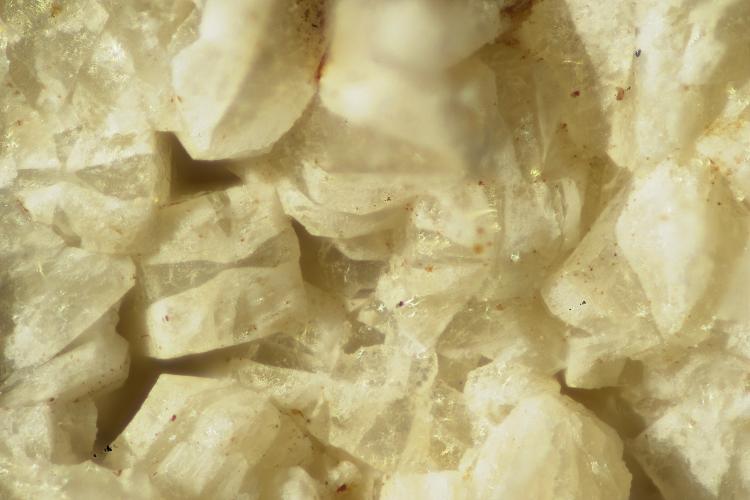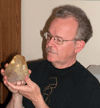| View previous topic :: View next topic |
| Author |
Message |
Brian Jackson
Joined: 13 Nov 2010
Posts: 7
Location: Edinburgh


|
 Posted: Jan 24, 2012 07:29 Post subject: Phillipsite - Marburg twin Posted: Jan 24, 2012 07:29 Post subject: Phillipsite - Marburg twin |
|
|
On the Isle of Lewis there is a very interesting late Tertiary dyke that contains acid rcok xenoliths, ultra basic xenoliths, megacrystals of augite, biotite, sapphire, apatite and sanidine. Tiny cavities in the camptonite/monchiquite dyke contain zeolites. All those examined so far proved to be phillipsite. This particular specimen has unusual colourless and milky white sector zoning. The overall morphology is that of a marburg twin but does anyone have any suggestions why there should be this colourless-milky white structural effect.
Brian Jackson
| Description: |
Phillipsite
Loch Roag, Isle of Lewis, Scotland
less than 1mm |
|
| Viewed: |
14501 Time(s) |

|
|
|
| Back to top |
|
 |
Mike Wood

Joined: 16 Dec 2010
Posts: 456
Location: Northern England



|
 Posted: Jan 25, 2012 12:54 Post subject: Re: Phillipsite - Marburg twin Posted: Jan 25, 2012 12:54 Post subject: Re: Phillipsite - Marburg twin |
|
|
Hello Brian,
maybe there is chemical variation in the crystal structure causing the sector-zoning in the phillipsite.
By the way, the phillipsite found at Moonen Bay on the Isle of Skye contains quite a lot of barium - I don't know if it's sector-zoned.
Regards, Mike
|
|
| Back to top |
|
 |
Pete Richards
Site Admin

Joined: 29 Dec 2008
Posts: 833
Location: Northeast Ohio



|
 Posted: Jan 25, 2012 13:21 Post subject: Re: Phillipsite - Marburg twin Posted: Jan 25, 2012 13:21 Post subject: Re: Phillipsite - Marburg twin |
|
|
| Mike Wood wrote: | Hello Brian,
maybe there is chemical variation in the crystal structure causing the sector-zoning in the phillipsite..... |
I don't think this is sector zoning, at least of the usual type, which is a compositional difference between volumes of a crystal that grew by deposition on different faces of the crystal. I thought of that initially as well, but the problem is that the zones do not correspond to face boundaries.
Remembering that these are twins, it is possible that they grew initially with +-shaped cross sections, then the notches later filled in with whiter material, though why that might happen is anybody's guess.
It would be interesting to know if there's a compositional difference between the colorless and the white, or whether e.g. the white is shot full of small voids or included debris.
_________________
Collecting and studying crystals with interesting habits, twinning, and epitaxy |
|
| Back to top |
|
 |
John S. White
Site Admin

Joined: 04 Sep 2006
Posts: 1297
Location: Stewartstown, Pennsylvania, USA



|
 Posted: Jan 25, 2012 14:11 Post subject: Re: Phillipsite - Marburg twin Posted: Jan 25, 2012 14:11 Post subject: Re: Phillipsite - Marburg twin |
|
|
This reminds me somewhat of what one rarely sees with tourmaline, almost "trapiche" like, which results in the Mercedes symbol in cross-section. Remember that phillipsite interpenetration twins often look like a phillips screw driver, with twin arms going out in four directions. In this case, it appears that subsequent in-filling occurred between the arms of the twin with less transparent phillipsite, or another species altogether. This is essentially what Pete surmised.
_________________
John S. White
aka Rondinaire |
|
| Back to top |
|
 |
Pete Modreski
Site Admin

Joined: 30 Jul 2007
Posts: 709
Location: Denver, Colorado



|
 Posted: Jan 25, 2012 15:06 Post subject: Re: Phillipsite - Marburg twin Posted: Jan 25, 2012 15:06 Post subject: Re: Phillipsite - Marburg twin |
|
|
| John S. White wrote: | | Remember that phillipsite interpenetration twins often look like a phillips screw driver, with twin arms going out in four directions... |
Aha, so THAT'S why phillipsite is named thus! Or maybe, why a phillips screwdriver is so named... who would have guessed!
(What, you think I may be a bit off base here?)
|
|
| Back to top |
|
 |
Pete Richards
Site Admin

Joined: 29 Dec 2008
Posts: 833
Location: Northeast Ohio



|
 Posted: Jan 25, 2012 16:30 Post subject: Re: Phillipsite - Marburg twin Posted: Jan 25, 2012 16:30 Post subject: Re: Phillipsite - Marburg twin |
|
|
| Pete Modreski wrote: | | John S. White wrote: | | Remember that phillipsite interpenetration twins often look like a phillips screw driver, with twin arms going out in four directions... |
Aha, so THAT'S why phillipsite is named thus! Or maybe, why a phillips screwdriver is so named... who would have guessed!
(What, you think I may be a bit off base here?) |
Phillipsite was named for William Phillips (1775-1829), British mineralogist and founder of the Geological Society of London, and inventor of the Phillips screwdriver. Quoting from Dana's System 8th edition....
... with minor embellishment!
_________________
Collecting and studying crystals with interesting habits, twinning, and epitaxy |
|
| Back to top |
|
 |
crocoite

Joined: 06 Feb 2009
Posts: 490
Location: Ballarat, Victoria



|
 Posted: Jan 25, 2012 16:43 Post subject: Re: Phillipsite - Marburg twin Posted: Jan 25, 2012 16:43 Post subject: Re: Phillipsite - Marburg twin |
|
|
Hi Pete and Pete
The Phillips Head was invented in the 1930s by Henry Phillips. William Phillips had been dead for over a century.
Regards
Steve
|
|
| Back to top |
|
 |
Pete Richards
Site Admin

Joined: 29 Dec 2008
Posts: 833
Location: Northeast Ohio



|
 Posted: Jan 25, 2012 16:58 Post subject: Re: Phillipsite - Marburg twin Posted: Jan 25, 2012 16:58 Post subject: Re: Phillipsite - Marburg twin |
|
|
| crocoite wrote: | Hi Pete and Pete
The Phillips Head was invented in the 1930s by Henry Phillips. William Phillips had been dead for over a century.
Regards
Steve |
Oh, well drat. I was just trying to give “artistic versimilitude to an otherwise bald and unconvincing narrative”, to quote Gilbert and Sullivan's 'Mikado'. Or something like that.
I guess William P. missed a great opportunity to be more widely famous.
I'll say no more.
_________________
Collecting and studying crystals with interesting habits, twinning, and epitaxy |
|
| Back to top |
|
 |
Brian Jackson
Joined: 13 Nov 2010
Posts: 7
Location: Edinburgh


|
 Posted: Jan 26, 2012 09:27 Post subject: Re: Phillipsite - Marburg twin Posted: Jan 26, 2012 09:27 Post subject: Re: Phillipsite - Marburg twin |
|
|
Dear All
Many thanks for your thoughts. There is indeed a strong temptation to think the the interpenetration angles have been filled in but for the love of me I can't think of any mechanism that would be so selective. Maybe some analysis is required. It would certainly inform opinion. The Strontian harmotome which, as often as not, forms marburg twins, is normally, in larger crystal, transparent when found, but turns white on exposure to storage conditions, presumably due to loss of non-structural water. Natrolite and analcime show a similar effect although in the case of natrolite it may be structural water such as occurs with laumontite. What do folk think about variable water as a cause?
Cheers
Brian
|
|
| Back to top |
|
 |
dtkasper
Joined: 27 Dec 2010
Posts: 13
Location: Lancaster


|
 Posted: Apr 21, 2012 04:58 Post subject: Re: Phillipsite - Marburg twin Posted: Apr 21, 2012 04:58 Post subject: Re: Phillipsite - Marburg twin |
|
|
| How about dehydration of phillipsite to andalusite. The byproducts would be silica, water, and calcium oxide. That CaO would be your colorant. The crystalline end-on look being cubic then matches andalusite. Otherwise, the first problem is explaining why the phillipsite is not orbicular.
|
|
| Back to top |
|
 |
|


